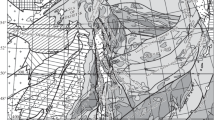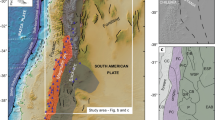Abstract
We deal with modelling of the geoid undulations for the European Plate by use of topographic and Moho data. Two models assuming linear density stratification in the lithosphere (constant contrast model CCM, constant gradient model CGM) and isostatic balance of the lithosphere were used for calculating the undulation in the flat layer approximation. The results show that the constant contrast model is able to describe the entire oceanic lithosphere, as it indicates the amplitude of thermal density change is in good agreement with the cooling plate model estimation. The constant gradient model gives reliable estimations of the lithosphere properties only in smaller regions of relatively uniform conditions like the Interior of the East European Craton. For continental and oceanic regions the resulting values of the density gradient have some average meaning and they are in interpretable correspondence with characteristic mantle heat flow. In the entire area, both models show strong confusion giving not intermediate and unrealistic lithosphere characterization, which is a result of essential differences of thermal constitution, differences in average crustal density and mineral differences of the lower lithosphere, occurring between the two major tectonic provinces (oceanic and continental). The convention of equivalent linear reduction was discussed extensively and applied as an adequate method of lithosphere thickness estimation. This approach leads to thickness determination similar to other methods (seismic, petrological and thermal). The two concepts allow for the construction of LAB (transitional zone between the lithosphere and asthenosphere) depth maps from topographic and Moho data.
Similar content being viewed by others
References
Angevine C.L. and Turcotte D.L., 1980. On the compensation mechanism of the Walvis Ridge. Geophys. Res. Lett., 7, 477–479.
Artemiev M.E., Babaeva T.M., Mikhailo V.O. and Voydetsky I.E., 1984. Identification of mantle and lithospheric components of the gravity field by isostatic gravity anomalies. Mar. Geophys. Res., 7, 129–148.
Artemieva I.M., 2011. The lithosphere: An interdisciplinary approach. Cambridge University Press, Cambridge U.K.
Artemieva I.M. and Mooney W.D., 2001. Thermal thickness and evolution of Precambrian lithosphere: A global study. J. Geophys. Res., 106(B), 16387–16414.
Barrell J., 1914a. The strength of the Earth’s crust. Part IV. Heterogeneity and rigidity of the crust as measured from isostasy. J. Geol., 22(4), 289–314, DOI: 10.1086/622155.
Barrell J., 1914b. The strength of the Earth’s crust. Part V. The depth of masses producing gravity anomalies and deflection residuals J. Geol., 22(5), 441–468, DOI: 10.1086/622163.
Barrell J., 1914c. The strength of the Earth’s crust. Part V. The depth of masses producing gravity anomalies and deflection residuals. J. Geol., 22(6), 537–555, DOI: 10.1086/622170.
Barrell J., 1914d. The strength of the Earth’s crust. Part VI. Relations of isostatic movements to a sphere of weakness — the asthenosphere. J. Geol., 22(7), 655–683, DOI: 10.1086/622181.
Becker J.J., Sandwell D.T., Smith W.H.F., Braud J., Binder B., Depner J., Fabre D., Factor J., Ingalls S., Kim S-H., Ladner R., Marks K., Nelson S., Pharaoh A., Sharman G., Trimmer R., von Rosenbürg J., Wallace G. and Wetherall P., 2009. Global bathymetry and elevation data at 30 arc seconds resolution: SRTM30_plus. Mar. Geodesy, 32, 355–371 (http://topex.ucsd.edu/sandwell/publications/124_MG_Becker.pdf).
Braitenberg C. and Ebbing J., 2009. The GRACE-satellite gravity and geoid fields in analysing large-scale, cratonic or intracratonic basins. Geophys. Prospect., 57, 559–571, DOI: 10.1111/j.1365-2478.2009.00793.x.
Carlson R.L., Snow K.R. and Wilkens R.H., 1988. Density of old oceanic crust: an estimate derived from downhole logging on ODP Leg 102. In: Mazullo E.K. (Ed.), Proceedings of the Ocean Drilling Program, Scientific Results, 102. Ocean Drilling Program, College Station, TX, 63–68. DOI: 10.2973/odp.proc.sr.102.124.1988.
Carlson R.L. and Herrick C.N., 1990. Densities and porosities in the oceanic crust and their variations with depth and age. J. Geophys. Res., 95(B6), 9153–9170.
Cazenave A., Lago B. and Dominh K., 1983. Thermal Parameters of the Oceanic Lithosphere Estimated from Geoid Height Data. J. Geophys. Res., 88(B2), 1105–1118.
Crough S.T., 1982. Geoid height anomalies over the Cape Verde Rise. Mar. Geophys. Res., 5, 263–271.
Dawson J.B., 2008. The Gregory Rift Valley and Neogene-Recent Volcanoes of Northern Tanzania. Geol. Soc. Memoir 33. The Geological Society, London U.K.
Denis C., 1989. The hydrostatic figure of the Earth. In: Teisseyre R. (Ed.), Gravity and Low Frequency Geodynamics. Physics and Evolution of the Earth’s Interior, Vol. 4. PWN-Polish Scientific Publishers, Warszawa, Poland and Elsevier, Amsterdam, The Netherlands.
Dérerová J., Zeyen H., Bielik M. and Salman K., 2006. Application of integrated geophysical modeling for determination of the continental lithospheric thermal structure in the eastern Carpathians. Tectonics, 25, TC3009.
Fullea J., Fernàndez M., Zeyen H. and Vergés J., 2007. A rapid method to map the crustal and lithospheric thickness using elevation, geoid anomaly and thermal analysis. Application to the Gibraltar Arc System and adjacent zones. Tectonophysics, 430, 97–117, DOI: 10.1016/j.lithos.2010.03.003.
Geissler W.H., Kind R. and Yuan X., 2008. Upper mantle and lithospheric heterogeneities in central and eastern Europe as observed by teleseismic receiver functions. Geophys. J. Int., 174, 351–376, DOI: 10.1111/j.1365-246X.2008.03767.x.
Grad M., Tiira T. and ESC Working Group, 2009. The Moho depth map of the European Plate. Geophys. J. Int., 176, 279–292, DOI: 10.1111/j.1365-246X.2008.03919.x.
Gribble R.F., Stern R.J., Newman S., Bloomer Sh.H. and O’Hearn T., 1998. Chemical and Isotopic Composition of Lavas from the Northern Mariana Trough: Implications for Magma genesis in Back-arc Basins. J. Petrol., 39, 125–154.
Gudfinnsson G.H. and Presnall D.C., 2000. Melting behaviour of model lherzolite in the system CaO-MgO-Al2O3-SiO2-FeO at 0.7–2.8 GPa. J. Petrol., 41, 1241–1269.
Heestand R.L. and Crough S.T., 1981. The effect of hot spots on the oceanic age-depth relation. J. Geophys. Res., 86(B7), 6107–6114.
Hirschmann M.M., 2000. Mantle solidus: Experimental constraints and the effects of peridotite composition. Geochem. Geophys. Geosyst., 1, DOI: 10.1029/2000GC000070.
Horváth F., 1993. Towards a mechanical model for the formation of the Pannonian basin. Tectonophysics, 226, 333–357.
Jaupart C. and Mareschal J.-C., 2014. Constraints on Crustal Heat Production from Heat Flow Data. In: Holland H.D. and Turekian K.K. (Eds), Treatise on Geochemistry. Second Edition. Elsevier, Oxford U.K., 53–73, ISBN: 9780080983004.
Jokinen J. and Kukkonen I.T., 2000. Inverse Monte Carlo simulation of the lithospheric thermal regime in the Fennoscandian Shield using xenolith-derived mantle temperatures. J. Geodyn., 29, 71–85, DOI: 10.1016/S0264-3707(99)00011-3.
Kozlovskaya E., Kosarev G., Aleshin I., Riznichenko O. and Sanina I. 2008. Structure and composition of the crust and upper mantle of the Archean-Proterozoic boundary in the Fennoscandian shield obtained by joint inversion of receiver function and surface wave phase velocity of recording of the SVEKALAPKO array. Geophys. J. Int., 175, 135–152, DOI: 10.1111/j.1365-246X.2008.03876.x.
Krysinski L., 1992. On the mathematical connections of planetary rotational deformations with Love’s tidal problem. Phys. Earth Planet. Inter., 72(3-4), 137–152, DOI: 10.1016/0031-9201(92)90198-5.
Krysinski L., 2009. Systematic methodology for velocity-dependent gravity modelling of density crustal cross-sections, using an optimization procedure. Pure Appl. Geophys., 166, 375–408, DOI: 10.1007/s00024-009-0445-x.
Krysinski L., Grad M. and POLONAISE’97 Working Group, 2000. POLONAISE’97 — seismic and gravimetric modelling of the crustal structure in the Polish Basin. Phys. Chem. Earth A, 25, 355–363.
Krysinski L., Grad M. and Wybraniec S., 2009. Searching for regional crustal velocity-density relations with the use of 2-D gravity modelling — Central Europe case. Pure Appl. Geophys., 166, 1913–1936, DOI: 10.1007/s00024-009-0526-x.
Kuo B-Y. and Forsyth D.W., 1988. Gravity anomalies of the ridge-transform system in the South Atlantic between 31 and 34.5°S: upwelling centers and variations in crustal thickness. Mar. Geophys. Res., 10, 205–232.
Lachenbruch A.H. and Morgan P., 1990. Continental extension, magmatism and elevation; formal relations and rules of thumb. Tectonophysics, 174, 39–62.
Levander A., Lenardic A. and Karlstrom K.E., 2006. Structure of the continental lithosphere. In: Brown M. and Rushamer T. (Eds), Evolution and Differentiation of the Continental Crust. Cambridge University Press, Cambridge U.K., 21–66.
Majdanski M., Kozlovskaya E., Swieczak M. and Grad M., 2009. Interpretation of geoid anomalies in the contact zone between the East European Craton and the Palaeozoic Platform-I. Estimation of effects of density inhomogeneities in the crust on geoid undulations. Geophys. J. Int., 177, 321–333, DOI: 10.1111/j.1365-246X.2008.03954.x.
Martinec Z., 1994. The minimum depth of compensation to topographic masses. Geophys. J. Int., 117, 545–554.
Parsons B. and Sclater J.G., 1977. An analysis of the variation of ocean floor bathymetry and heat flow with age. J. Geophys. Res., 82(B5), 802–827.
Pasyanos M.E., 2010. Lithospheric thickness modeled from long-period surface wave dispersion. Tectonophysics, 481, 38–50.
Pavlis N.K., Holmes S.A., Kenyon S.C. and Factor J.K., 2008. An Earth Gravitational Model to degree 2160: EGM2008. Geophys. Res. Abs., 10, EGU2008-A-01891 (full version available at http://massentransporte.de/fileadmin/2kolloquium_muc/2008-10-08/Bosch/EGM2008.pdf).
Pollack H.N. and Chapman D.S., 1977. Mantle heat flow. Earth Planet. Sci. Lett., 34, 174–184.
Puziewicz J., Czechowski L., Krysinski L., Majorowicz J., Matusiak-Malek M. and Wróblewska M., 2012. Lithosphere thermal structure at the eastern margin of the Bohemian Massif: a case petrological and geophysical study of the Niedzwiedz amphibolite massif (SW Poland). Int. J. Earth Sci., 101, 1211–1228, DOI: 10.1007/s00531-011-0714-7.
Robert S.D., Needham H.D. and Renard V., 1995. Gravity anomalies and crustal thickness variations along the Mid-Atlantic Ridge between 33°N and 40°N. J. Geophys. Res., 100(B3), 3767–3787.
Sandwell D. and Schubert G., 1980. Geoid height versus age for symmetric spreading ridges. J. Geophys. Res., 85(B12), 7235–7241.
Schroeder W., 1984. The empirical age-depth relation and depth anomalies in the Pacific ocean basin. J. Geophys. Res., 89(B12), 9873–9883.
Schubert G., Froidevaux C. and Yuen D.A., 1976. Oceanic lithosphere and asthenosphere: thermal and mechanical structure. J. Geophys. Res., 81, 3525–3540.
Sclater J.G., Jaupart C. and Galson D., 1980. The heat flow through oceanic and continental crust and the heat loss of the Earth. Rev. Geophys., 18, 269–311.
Stacey F.D., 1992. Physics of the Earth. Problem Solutions. 3rd Edition. Brookfield Press, Kenmore, Qld.
Stacey F.D. and Davis P.M., 2008. Physics of the Earth. Fourth Edition. Cambridge University Press, Cambridge U.K.
Stevenson J.M. and Hildebrand J.A., 1996. Gravity modeling of a volcanically active site on the East Pacific Rise axis. Tectonophysics, 254, 57–68.
Swieczak M., Kozlovskaya E., Majdanski M. and Grad M., 2009. Interpretation of geoid anomalies in the contact zone between the East European Craton and the Palaeozoic Platform-II: Modelling of density in the lithospheric mantle. Geophys. J. Int., 177, 334–346, DOI: 10.1111/j.1365-246X.2009.04103.x.
Takahashi E. and Kushiro I., 1983. Melting of dry peridotite at high pressures and basalt magma genesis. Am. Miner., 68, 859–879.
Tari G., Dövényi P., Dunkl I., Horváth F., Lenkey L., Stefanescu M., Szafián P. and Tóth T., 1999. Lithospheric structure of the Pannonian basin derived from seismic, gravity and geothermal data. Geol. Soc. Spec. Publ., 156, 215–250.
Turcotte D.L. and Harris R.A., 1984. Relationship between the oceanic geoid and the structure of the oceanic lithosphere. Mar. Geophys. Res., 7, 177–190.
Turcotte D.L. and McAdoo D.C., 1979. Geoid anomalies and the thickness of the lithosphere. J. Geophys. Res., 84(B5), 2381–2387.
White R.S., McKenzie D. and O’Nions R.K., 1992. Oceanic crustal thickness from seismic measurements and rare earth element inversions. J. Geophys. Res., 97(B13), 19683–19715.
Zeyen H., Ayarza P., Fernàndez M. and Rimi A., 2005. Lithospheric structure under the western African-European plate boundary: A transect across the Atlas Mountains and the Gulf of Cadiz. Tectonics, 24, 1–16, DOI: 10.1029/2004TC001639.
Zeyen H., Dérerová J. and Bielik M., 2002. Determination of the continental lithospheric thermal structure in the Western Carpathians: Integrated modelling of surface heat flow, gravity anomalies and topography. Phys. Earth Planet. Inter., 134(1–2), 89–104.
Author information
Authors and Affiliations
Corresponding author
Rights and permissions
About this article
Cite this article
Krysiński, L., Wybraniec, S. & Grad, M. Lithospheric density structure study by isostatic modelling of the European geoid. Stud Geophys Geod 59, 212–252 (2015). https://doi.org/10.1007/s11200-014-1014-z
Received:
Revised:
Accepted:
Published:
Issue Date:
DOI: https://doi.org/10.1007/s11200-014-1014-z




